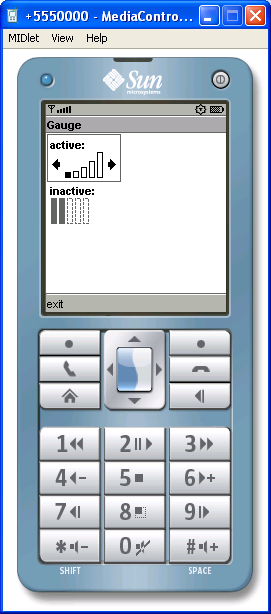Use active and inactive Gauge : Gauge « J2ME « Java Tutorial
- Java Tutorial
- J2ME
- Gauge

import javax.microedition.lcdui.Command;
import javax.microedition.lcdui.CommandListener;
import javax.microedition.lcdui.Display;
import javax.microedition.lcdui.Displayable;
import javax.microedition.lcdui.Form;
import javax.microedition.lcdui.Gauge;
import javax.microedition.midlet.MIDlet;
public class J2MEActiveInactiveGaugeMIDlet extends MIDlet implements CommandListener {
private Command exitCommand = new Command("exit", Command.EXIT, 1);
private Gauge activeGauge = new Gauge("active:", true, 10, 2);
private Gauge inactiveGauge = new Gauge("inactive:", false, 10, 4);
private Display display = Display.getDisplay(this);
public void startApp() {
Form aForm = new Form("Gauge");
aForm.append(activeGauge);
aForm.append(inactiveGauge);
aForm.addCommand(exitCommand);
aForm.setCommandListener(this);
display.setCurrent(aForm);
}
public void pauseApp() {
}
public void destroyApp(boolean unconditional) {
}
public void commandAction(Command c, Displayable s) {
if (c == exitCommand) {
destroyApp(false);
notifyDestroyed();
}
}
}